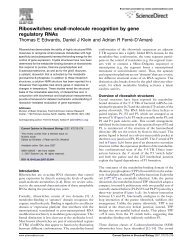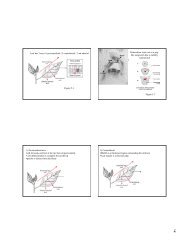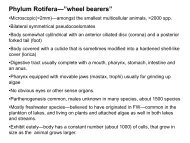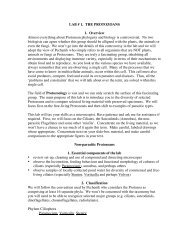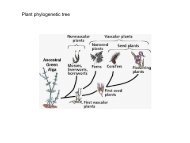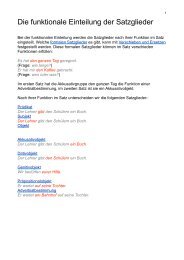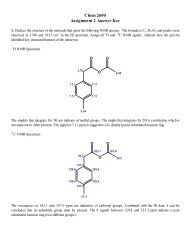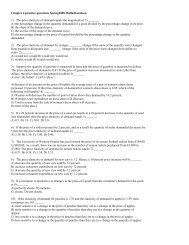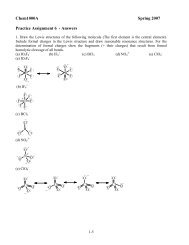You also want an ePaper? Increase the reach of your titles
YUMPU automatically turns print PDFs into web optimized ePapers that Google loves.
Chemistry 2810 <strong>Lecture</strong> Notes Dr. M. Gerken Page77<br />
5.2 Ionic structures<br />
We are now ready to consider a few of the most common ionic crystal structure types. Several of the Group 1 and 2<br />
halides have become common model systems for structural types that are used widely by ionic compounds of other elements,<br />
as well as some quite covalent transition metal oxides or sulfides, and even for some of the metallic alloys. Ions are obtained<br />
by the loss of electrons from or addition of electrons to a neutral atom.<br />
Li (1s 2 2s 1 ) Li + (1s 2 )<br />
F 1s 2 2s 2 2p 5 F – (1s 2 2s 2 2p 6 )<br />
This results in dramatic changes in the sizes of the ions, as shown graphically below:<br />
The radii changes involved for Li and F are as follows: Li is 1.52 Å, Li + 0.90 Å, F 0.72 Å, F – 1.19 Å. This translates into an<br />
astounding 5-fold reduction in volume for lithium, and a 4-fold increase in volume for fluorine!<br />
It is therefore not surprising that in most ionic structures the anions are considerably larger than the cations. This can be<br />
verified readily from the graphic presentation of some common ionic radii arranged in periodic table format below. A few<br />
exceptions to this general rule can be obtained if the largest cations are combined with the smallest anions (e.g. CsF).<br />
Be 2+ Fe 2+<br />
Li + Graphical Comparison of CN6 Radii of Cations and Anions N 3- O 2- F -<br />
Fe 3+<br />
Al 3+ Sb 5+<br />
Na +<br />
Mg 2+<br />
S 2-<br />
Cl-<br />
Sc 3+ Ti 4+ V 5+ Cr 3+ Co 2+ Ni 2+ Cu + Zn 2+ Ga 3+<br />
Ca 2+<br />
K + Mn 2+ Se2- Br -<br />
Rb + Sr 2+<br />
Ag + Cd 2+ In 3+ Te 2- I -<br />
Sn 4+<br />
Cs + Ba 2+ Au 2+ Hg 2+ Tl 3+ Pb 4+<br />
The definition of ionic radius is not without dispute, and in fact ion size<br />
depends on the structures within which they occur. Obviously they also<br />
depend on the oxidation state of the ion, as emphasized for the iron ions in the<br />
chart above. Ionic radii are determined from X-ray crystallography. The<br />
earliest determinations used simple geometric factors to calculate average<br />
radii. More recently, accurate electron density maps have been used to obtain<br />
more reliable estimates of absolute ion radii. Consider the plot of electron<br />
density in a crystal of lithium fluoride shown at right. The actual minimum in<br />
the electron density distribution is indicated at 0.92 Å. The original Pauling<br />
radii puts Li at 0.60 Å (a value often presented in General Chemistry texts),<br />
while the more accurate Shannon-Prewitt radius of Li with CN6 is 0.90 Å.<br />
This is clearly a better estimate of the location where the cation ends and the<br />
anion begins. But for such a shallow minimum, considerable variation - and<br />
dispute - is expected to exist. A detailed list of the most up-to-date Shannon-<br />
Prewitt ionic radii follows.
Chemistry 2810 <strong>Lecture</strong> Notes Dr. M. Gerken Page78<br />
1 18<br />
He<br />
13 14 15 16 17<br />
H<br />
+1 -0.24(1)<br />
-0.04(2) 2<br />
Chemistry 2810 Ionic Radii (Å)<br />
Li<br />
+1 0.73(4)<br />
0.90(6)<br />
1.06(8)<br />
Na<br />
+1 1.13(4)<br />
1.16(6)<br />
1.30(8)<br />
1.53(12)<br />
K<br />
+1 1.52(6)<br />
1.65(8)<br />
1.73(10)<br />
1.78(12)<br />
Rb<br />
+1 1.66(6)<br />
1.75(8)<br />
1.80(10)<br />
1.86(12)<br />
1.97(14)<br />
Cs<br />
+1 1.81(6)<br />
1.88(8)<br />
1.95(10)<br />
2.02(12)<br />
Fr<br />
+1 1.94(6)<br />
Be<br />
+2 0.31(3)<br />
0.41(4)<br />
0.59(6)<br />
Mg<br />
+2 0.71(4)<br />
0.86(6)<br />
1.03(8)<br />
Ca<br />
+2 1.14(6)<br />
1.26(8)<br />
1.37(10)<br />
1.48(12)<br />
Sr<br />
+2 1.32(6)<br />
1.40(8)<br />
1.50(10)<br />
1.58(12)<br />
Ba<br />
+2 1.49(6)<br />
1.56(8)<br />
1.66(10)<br />
1.75(12)<br />
Ra<br />
+2 1.62(8)<br />
1.84(12)<br />
χ ≤ 1.50<br />
Sc<br />
+3 0.885(6)<br />
1.010(8)<br />
Y<br />
+3 1.040(6)<br />
1.159(8)<br />
Lu<br />
+3 1.001(6)<br />
1.117(8)<br />
χ ≥ 1.50<br />
3 4 5 6 7 8 9 10 11 12<br />
Lr<br />
Ti<br />
+2 1.00(6)<br />
+3 0.81(6)<br />
+4 0.56(4)<br />
0.745(6)<br />
0.88(8)<br />
Zr<br />
+4 0.73(4)<br />
0.86(6)<br />
0.98(8)<br />
Hf<br />
+4 0.72(4)<br />
0.85(6)<br />
0.97(8)<br />
V<br />
+2 0.93(6)<br />
+3 0.78(6)<br />
+4 0.72(6)<br />
0.86(8)<br />
+5 0.494(4)<br />
0.68(6)<br />
Nb<br />
+3 0.86(6)<br />
+4 0.82(6)<br />
0.93(8)<br />
+5 0.62(4)<br />
0.78(6)<br />
0.88(8L)<br />
0.92(8H)<br />
Ta<br />
+3 0.86(6)<br />
+4 0.82(6)<br />
+5 0.78(6)<br />
0.88(8)<br />
Cr<br />
+2 0.87(6L)<br />
0.94(6H)<br />
+3 0.76(6)<br />
+4 0.55(4)<br />
0.69(6)<br />
+5 0.49(4)<br />
0.71(8)<br />
+6 0.44(4)<br />
0.58(6)<br />
Mo<br />
+3 0.83(6)<br />
+4 0.79(6)<br />
+5 0.60(4)<br />
0.75(6)<br />
+6 0.55(4)<br />
0.73(6)<br />
W<br />
+4 0.80(6)<br />
+5 0.76(6)<br />
+6 0.56(4)<br />
0.74(6)<br />
Mn<br />
+2 0.81(6L)<br />
0.96(6H)<br />
1.07(8)<br />
+3 0.72(6L)<br />
0.79(6H)<br />
+4 0.67(6)<br />
+7 0.39(4)<br />
0.60(6)<br />
Tc<br />
+4 0.785(6)<br />
+5 0.74(6)<br />
+7 0.51(4)<br />
0.70(6)<br />
Re<br />
+4 0.77(6)<br />
+5 0.72(6)<br />
+6 0.69(6)<br />
+7 0.52(4)<br />
0.67(6)<br />
Fe Co<br />
+2 0.77(4H) +2 0.72(4H)<br />
0.75(6L) 0.79(6L)<br />
0.92(6H) 0.88(6H)<br />
+3 0.63(4H) +3 0.67(6L)<br />
0.69(6L) 0.75(6H)<br />
0.785(6H)<br />
Ru<br />
+3 0.82(6)<br />
+4 0.76(6)<br />
+5 0.705(6)<br />
+7 0.52(4)<br />
+8 0.52(8)<br />
Os<br />
+4 0.77(6)<br />
+5 0.715(6)<br />
+6 0.685(6)<br />
+7 0.665(6)<br />
+8 0.53(4)<br />
Rh<br />
+3 0.805(6)<br />
+4 0.74(6)<br />
+5 0.69(6)<br />
Ir<br />
+3 0.82(6)<br />
+4 0.765(6)<br />
+5 0.71(6)<br />
Ni<br />
+2 0.69(4)<br />
0.83(6)<br />
+3 0.70(6L)<br />
0.74(6H)<br />
+4 0.62(6L)<br />
Pd<br />
+2 0.78(4SQ)<br />
1.00(6)<br />
+3 0.90(6)<br />
+4 0.755(6)<br />
Pt<br />
+2 0.74(4SQ)<br />
0.94(6)<br />
+4 0.765(6)<br />
+5 0.71(6)<br />
Cu Zn<br />
+1 0.60(2) +2 0.74(4)<br />
1.74(4) 0.880(6)<br />
1.91(6) 1.04(8)<br />
+2 0.76(4SQ)<br />
0.87(6)<br />
+3 0.68(6L)<br />
Ag<br />
+1 0.81(2)<br />
1.14(4)<br />
1.16(4SQ)<br />
1.29(6)<br />
1.42(8)<br />
+2 0.93(4SQ)<br />
1.08(6)<br />
+3 0.81(4SQ)<br />
0.89(6)<br />
Au<br />
+1 1.51(6)<br />
+3 0.82(4SQ)<br />
0.99(6)<br />
+5 0.71(6)<br />
Cd<br />
+2 0.92(4)<br />
1.09(6)<br />
1.24(8)<br />
1.45(12)<br />
Hg<br />
+1 1.11(3)<br />
1.33(6)<br />
+2 0.83(2)<br />
1.10(4)<br />
1.16(6)<br />
1.28(8)<br />
B<br />
+3 0.15(3)<br />
0.24(4)<br />
0.41(6)<br />
Al<br />
+3 0.53(4)<br />
0.675(6)<br />
Ga<br />
+3 0.61(4)<br />
0.76(6)<br />
In<br />
+3 0.76(4)<br />
0.940(6)<br />
1.06(8)<br />
Tl<br />
+1 1.64(6)<br />
1.73(8)<br />
1.84(12)<br />
+3 0.89(4)<br />
1.025(6)<br />
1.12(8)<br />
C<br />
+4 0.06(3)<br />
0.29(4)<br />
0.30(6)<br />
Si<br />
+4 0.40(4)<br />
0.540(6)<br />
Ge<br />
+2 0.87(6)<br />
+4 0.53(4)<br />
0.67(6)<br />
Sn<br />
+2 1.41(8)<br />
+4 0.69(4)<br />
0.83(6)<br />
0.95(8)<br />
N<br />
-3 1.32(4)<br />
+3 0.30(6)<br />
+5 0.044(3)<br />
0.27(6)<br />
P<br />
+3 0.58(6)<br />
+5 0.31(4)<br />
0.52(6)<br />
As<br />
+3 0.72(6)<br />
+5 0.475(4)<br />
0.60(6)<br />
Pb Bi<br />
+2 1.12(4PY) +3 1.17(6)<br />
1.33(6) 1.31(8)<br />
1.43(8) +5 0.90(6)<br />
1.63(12)<br />
+4 0.79(4)<br />
0.915(6)<br />
1.08(8)<br />
O<br />
-2 1.21(2)<br />
1.22(3)<br />
1.24(4)<br />
1.26(6)<br />
1.28(8)<br />
S<br />
-2 1.70(6)<br />
+6 0.26(4)<br />
0.43(6)<br />
Se<br />
-2 1.84(6)<br />
+4 0.64(6)<br />
+6 0.42(4)<br />
0.56(6)<br />
Sb Te<br />
+3 0.90(4PY) -2 2.07(6)<br />
0.90(6) 1.63(12)<br />
+5 0.74(6) +4 0.80(4)<br />
1.11(6)<br />
+6 0.57(4)<br />
0.70(6)<br />
Po<br />
+4 1.08(6)<br />
1.22(8)<br />
+6 0.81(6)<br />
F<br />
-1 1.145(2)<br />
1.16(3)<br />
1.17(4)<br />
1.19(6)<br />
+7 0.22(6)<br />
Cl<br />
-1 1.67(6)<br />
+5 0.26(3PY)<br />
+7 0.22(4)<br />
0.41(6)<br />
Br<br />
-1 1.82(6)<br />
+3 0.73(4SQ)<br />
+5 0.45(3PY)<br />
+7 0.39(4)<br />
0.53(6)<br />
I<br />
-1 2.06(6)<br />
+5 0.58(3PY)<br />
1.09(6)<br />
+7 0.56(4)<br />
0.67(6)<br />
At<br />
+7 0.76(6)<br />
1f 2f 3f 4f 5f 6f 7f 8f 9f 10f 11f 12f 13f 14f<br />
La<br />
+3 1.172(6)<br />
1.30(8)<br />
1.41(10)<br />
1.50(12)<br />
Ac<br />
+3 1.26(6)<br />
Ce<br />
+3 1.15(6)<br />
1.283(8)<br />
1.39(10)<br />
1.48(12)<br />
+4 1.01(6)<br />
1.11(8)<br />
1.21(10)<br />
1.28(12)<br />
Th<br />
+4 1.08(6)<br />
1.19(8)<br />
1.27(10)<br />
1.35(12)<br />
Pr<br />
+3 1.13(6)<br />
1.266(8)<br />
+4 0.99(6)<br />
1.10(8)<br />
Pa<br />
+3 1.18(6)<br />
+4 1.04(6)<br />
1.15(8)<br />
+5 0.92(6)<br />
1.05(8)<br />
Nd<br />
+2 1.43(8)<br />
+3 1.123(6)<br />
1.249(8)<br />
1.41(12)<br />
U<br />
+3 1.165(6)<br />
4+ 1.03(6)<br />
1.14(8)<br />
1.31(12)<br />
+5 0.90(6)<br />
+6 0.66(4)<br />
0.87(6)<br />
1.00(8)<br />
Pm<br />
+3 1.11(6)<br />
1.233(8)<br />
Np<br />
+2 1.24(6)<br />
+3 1.15(6)<br />
+4 1.01(6)<br />
1.12(8)<br />
+5 0.89(6)<br />
+6 0.86(6)<br />
+7 0.85(6)<br />
Sm<br />
+2 1.41(8)<br />
+3 1.098(6)<br />
1.219(8)<br />
1.38(12)<br />
Pu<br />
+3 1.14(6)<br />
+4 1.00(6)<br />
1.10(8)<br />
+5 0.88(6)<br />
+6 0.85(6)<br />
Eu<br />
+2 1.31(6)<br />
1.39(8)<br />
1.49(10)<br />
+3 1.087(6)<br />
1.206(8)<br />
Am<br />
+2 1.40(8)<br />
+3 1.115(6)<br />
1.23(8)<br />
+4 0.99(6)<br />
1.09(8)<br />
Gd<br />
+3 1.078(6)<br />
1.193(8)<br />
Cm<br />
+3 1.11(6)<br />
+4 0.99(6)<br />
1.09(8)<br />
Tb<br />
+3 1.063(6)<br />
1.180(8)<br />
+4 0.90(6)<br />
1.02(8)<br />
Bk<br />
+3 1.10(6)<br />
+4 0.97(6)<br />
1.07(8)<br />
Dy<br />
+2 1.21(6)<br />
1.33(8)<br />
+3 1.052(6)<br />
1.167(8)<br />
Cf<br />
+3 1.09(6)<br />
+4 0.961(6)<br />
1.06(8)<br />
Ho<br />
+3 1.041(6)<br />
1.155(8)<br />
1.26(10)<br />
Er<br />
+3 1.03(6)<br />
1.144(8)<br />
Tm<br />
+2 1.17(6)<br />
+3 1.02(6)<br />
1.134(8)<br />
Yb<br />
+2 1.16(6)<br />
1.28(8)<br />
+3 1.008(6)<br />
1.125(8)<br />
Es Fm Md No<br />
+2 1.24(6)<br />
NOTES: (4) = tetrahedral unless SQ; (6) = octahedral; (8) = sq. anti-prism; (>8) not defined; H = high spin; L = low spin; Source of data: R.D. Shannon Acta Cryst. (1976) A32, 751<br />
Ne<br />
Ar<br />
Kr<br />
Xe<br />
+8 0.54(4)<br />
0.62(6)<br />
Rn
Chemistry 2810 <strong>Lecture</strong> Notes Dr. M. Gerken Page79<br />
5.2.1. Common ionic crystal structures<br />
The common ionic structures that we will consider in detail are depicted in the following picture. In each case, the smaller<br />
circles represent the cations, while the larger circles represent the anions. This kind of open-lattice unit cell picture shows the<br />
ions at 20% or less of their true radii. This gives the advantage that it is possible to see inside the cell and observe the relative<br />
orientation of the ions and their chemical connectivity. It should be borne in mind that in reality in all ionic lattices the cations<br />
and the anions ought to be in contact. The anions may also contact the other anions, but more normally they are somewhat<br />
pulled apart. An anion-anion contact is electrostatically repulsive, while the cation-anions contacts are attractive. Some<br />
alternate graphical representations are provided later on for some of these structures. Note that some of these will be<br />
stereoviews. These can simulate a 3-dimensional look. To see the perspective in such structures, one relaxes the eyes and<br />
allows then to cross, such that the stereo image forms mid-way between the two flat images. Alternatively, separate the two<br />
views from the other eye by holding a piece of white cardboard between the images, extending from the surface of the paper to<br />
the observers eyes.
Chemistry 2810 <strong>Lecture</strong> Notes Dr. M. Gerken Page80<br />
a) NaCl lattice<br />
AB stoichiometry Cation : anion ratio is 1:1<br />
Each Na ion and Cl ion has six nearest neighbours, so that the<br />
coordination number, CN = 6.<br />
Na-Cl-Na angles are 180° and 90°.<br />
Coordinates: Cl – (0, 0, 0) (½,½, 0) (½, 0, ½) (0, ½, ½)<br />
Na + (0, ½, ½) (½, 0, ½) (½, ½, 0) (½, ½, ½)<br />
Consider the "sliced" view at the right. Note the strong similarity to the<br />
FCC metallic lattice. In fact, the Cl – ions are arranged just the same as the<br />
metals in FCC. This leaves the larger O h holes for the Na + to occupy, which<br />
leads to a single sodium ion at the center of the unit cell, and 12 in total<br />
along the centres of each unit cell edge. These edge atoms are on ¼ within the volume of the cubic cell. The next image is<br />
known as a stereoview, and gives 3-D insight into the structure. Note that in this graphic, the positions of the sodium and<br />
chloride ions have been reversed, and this serves to emphasize the important fact that the NaCl structure is interchangeable<br />
between cation and anion.<br />
b) CsCl lattice<br />
AB stoichiometry<br />
Eight nearest neighbours. CN = 8.<br />
Angles 180°, 70.5° & 109.5°<br />
Coordinates: Cs + at (½, ½, ½)<br />
Cl – at (0, 0, 0)<br />
Here again there is a "sliced" view that allows us to accurately count the unit<br />
cell contents. The eight chloride ions at the corners each contribute only 1/8 th of<br />
their volume to the cell, while the central cesium ion is completely within the cell.<br />
It is a common mistake to call this structure "body-centred cubic" - this is false; in<br />
fact the lattice type is primitive cubic, with the central cesium ion occupying the<br />
cubic hole There is one net CsCl formula per unit cell.
Chemistry 2810 <strong>Lecture</strong> Notes Dr. M. Gerken Page81<br />
c) Zinc blende (cubic ZnS), Sphalerite<br />
AB stoichiometry<br />
CN = 4 for cation and for anion.<br />
Angles 109.5° . Tetrahedra set on one edge.<br />
S: (0, 0, 0) (½ , ½, 0) (½, 0, ½) (0, ½, ½)<br />
Zn: (¼, ¼, ¼) (¼, ¼, ¾) (¾, ¼, ¾) ( ¾ , ¾, ¼)<br />
This structure is closely related to the diamond structure, but the arrangement of the anions is FCC. Thus every second<br />
tetrahedral hole in the lattice is occupied by the cations. There is a close geometrical affinity to the diamond structure, and in<br />
fact it is like diamond with every second carbon atom replaced by a sulfur atom.<br />
d) Wurtzite (hexagonal ZnS)<br />
AB stoichiometry<br />
CN = 4 for both ions<br />
Angles 109.5°. Tetrahedra sitting on a face.<br />
The local geometry is almost identical to that of zinc blende, but the overall symmetry of the lattice is hexagonal, not<br />
cubic. The anion packing is hcc with the cations occupying half of the tetrahedral holes.<br />
e) Fluorite (CaF 2 )<br />
AB 2 stoichiometry<br />
CN = 8 for cation; CN = 4 for anion.<br />
Ca-F-Ca angles are 109.5° ; F-Ca-F angles are 180, 109.5 and 70.5°.<br />
In this structure, Ca 2+ is actually larger than the F - anion. Therefore, we consider the packing of the cation being fcc with<br />
anions occupying all tetrahedral holes.
Chemistry 2810 <strong>Lecture</strong> Notes Dr. M. Gerken Page82<br />
f) Antifluorite (e.g. K 2 O) (same pictures as fluorite)<br />
A 2 B stoichiometry<br />
CN = 4 for cation; CN = 8 for anion.<br />
Ca-F-Ca angles are 109.5°; F-Ca-F angles are 180°, 109.5° and 70.5°.<br />
O-K-O angles are 109.5°; K-O-K angles are 180°, 109.5° and 70.5°.<br />
g) Rutile (TiO 2 )<br />
AB 2 stoichiometry.<br />
CN = 6 for cation; CN = 3 for anion.<br />
Ti-O-Ti angles are 120°; O-Ti-O angles are 180° and 90°.<br />
In applying the close packed model, we imagine just the larger of the ions forming a close-packed lattice, in which the<br />
anions exist as spheres just touching each other (for antilattices, the cations.) These anions are held in place, however, not by a<br />
metallic bond, but by electrostatic attraction for cations, which occupy the T d and O h holes.<br />
Now, having said this, considerable expansion of the "close-packed" structure may occur. I.e. the cations may be larger<br />
than the basic size of the holes, and the anions may be in the same position as in a close-packed structure, but no longer<br />
touching. Later we will consider what kind of size criteria cause alterations from the close-packed structures.<br />
Not all ionic compounds can be understood by this model. Those which can include the following:<br />
AB type:<br />
- NaCl: ccp array of Cl - ; Na + in all the O h holes.<br />
[Note it is a special property of the ccp array alone, that the O h holes describe a ccp array of their own. Thus NaCl<br />
is often spoken of as two interpenetrating ccp arrays, one of Cl - , the other of Na + , displaced from each other by<br />
a/2.]<br />
- Zinc blende: ccp array of S 2- ; Zn 2+ in every second T d hole.<br />
- Wurtzite: hcp array of S 2- ; Zn 2+ in every second T d hole.<br />
- CsCl: is not a close packed array.<br />
-<br />
AB 2 type:<br />
- Fluorite (CaF 2 ): ccp array of Ca 2+ (i.e. this is an anti-lattice), F - in all T d holes.
Chemistry 2810 <strong>Lecture</strong> Notes Dr. M. Gerken Page83<br />
- Antifluorite: the reverse of CaF 2 , where a 2- anion is ccp; 1+ cations in T d holes<br />
- Rutile: cannot be described in such a way (distorted close packing)<br />
Remember that this is only one possible way of describing ionic solids. An alternate approach is to categorize each<br />
separately by their main structural features, as is done below.<br />
It is not easy to explain why certain ionic solids adopt certain structures! Whole books have been written on this subject<br />
(see the reading list at the end of chapter 4). We will restrict ourselves to just one such rationalization, specifically that the<br />
choice between various types of lattices is chiefly governed by relative ion sizes. Go back to our story of the sodium and<br />
fluoride ions approaching each other. Presumably they will stop when they reach each other.<br />
A cation and anion will approach till they gently nudge; closer than this will set up repulsion between the outer electrons in<br />
each electron:<br />
Attractive forces<br />
+<br />
−<br />
Approaching<br />
Attractive forces<br />
e -<br />
e -<br />
+<br />
−<br />
e -<br />
e -<br />
e - e -<br />
+<br />
e - e - −<br />
e - e -<br />
Repulsive forces<br />
Just touching<br />
Interpenetrating<br />
In the lattice, we want to maximize cations and anions just touching, for this is the greatest Coulombic attraction. But we<br />
want to avoid anion-anion touching, since these are purely repulsive interactions. So the ideal packing of an ionic crystal is ion<br />
pairs touching, but cations well separated.<br />
This is where the idea of coordination number comes in, because what the most favourable interactions will be depends on<br />
relative ion sizes. The radius ratio expresses the relative size of the cation and the anion. For each type of lattice, we can<br />
calculate the ideal radius ratio for perfect packing using solid geometry. This is the minimum radius ratio that this type of<br />
structure will tolerate; any thing less and the anions will remain touching, but the ion-pairs are no longer touching. When this<br />
occurs, the lattice will switch to one with lower coordination number.<br />
Consider the CsCl structure: (See the figures above, especially the stereodiagrams). We will now map out the CsCl<br />
diagonal plane. That is a plane which stretches from one box-edge of the cube to the diagonally opposed box edge. This plane<br />
will have sides with length of the box edge (two sides) and box face-diagonal (other two sides).<br />
The radius of the anions is just r - = a/2.<br />
The radius of the cation is determined as follows:<br />
Cl - Cl -<br />
x = a√ 3<br />
2<br />
+ −<br />
a 3<br />
r + r = dCs−Cl<br />
=<br />
2<br />
Solving both equations gives r + /r _ = 0.73. (Note that for<br />
fluorite and other "reversed" lattices, the radius ratio is r - /r + .)<br />
Try such calculations yourself for NaCl and zinc blende.<br />
Cl -<br />
x<br />
Cs +<br />
•<br />
Cl -<br />
r - = a/2<br />
r - + r + = a√ 3<br />
2<br />
r + = a√ 3 - a/2<br />
2<br />
= a ( √ 3 -1 )<br />
2<br />
r + /r - = 0.732<br />
a<br />
In practice, the range of radius ratio values which still lead to the same structure are given in the following table. The first<br />
number in each range is the limiting ratio. Drop below this number, and the lattice should jump back to the structure with<br />
lower coordination number. The upper number is the limit of the range in which lattice expansion, or loss of anion-anion<br />
contact, occurs without altering the lattice type.
Chemistry 2810 <strong>Lecture</strong> Notes Dr. M. Gerken Page84<br />
Stoichiometry r + /r _ Lattice type<br />
1:1 C.N.<br />
0.00-0.155 3 No examples<br />
0.225-0.414 4 Wurtzite and zinc blende<br />
0.414-0.732 6 NaCl<br />
0.732-1.00 8 CsCl<br />
1:2 C.N. of smaller ion<br />
0.225-0.414 4 b-quartz (not dealt with previously)<br />
0.414-0.732 6 Rutile<br />
0.732-1.00 8 Fluorite (note r(Ca 2+ ) / r(F - )<br />
Summing it up in words: when the cations are large, many anions can surround the cation; this leads to the CsCl structure.<br />
For smaller cations, the NaCl lattice is observed, and for the largest anions, such as S 2- , the ZnS structures are favoured. Note<br />
these are only rules of thumb.<br />
SAMPLE PROBLEMS<br />
Predict the coordination numbers of the following ionic solids:<br />
MgF 2 use CN=6 radii r + /r - = .72/1.31 = 0.55<br />
Predict rutile structure; but if use CN=4 radius of Mg 2+ , get 0.37; this suggests the b-quartz<br />
structure; in fact is Rutile<br />
KBr use CN=6 radii r + /r - = 1.52/1.82 = 0.835<br />
Predict CsCl; in fact is NaCl.<br />
LiCl use CN=6 radii r + /r - = 0.90/1.67 = 0.455<br />
Predict NaCl, correctly<br />
In fact, the radius ratio rule is least reliable for simple ionic halides and oxides, and most reliable for complex mixed-metal<br />
fluorides and for salts of the oxoanions like perchlorate. Radii for the latter are given in Table 4.5, p. 129 of the text.





